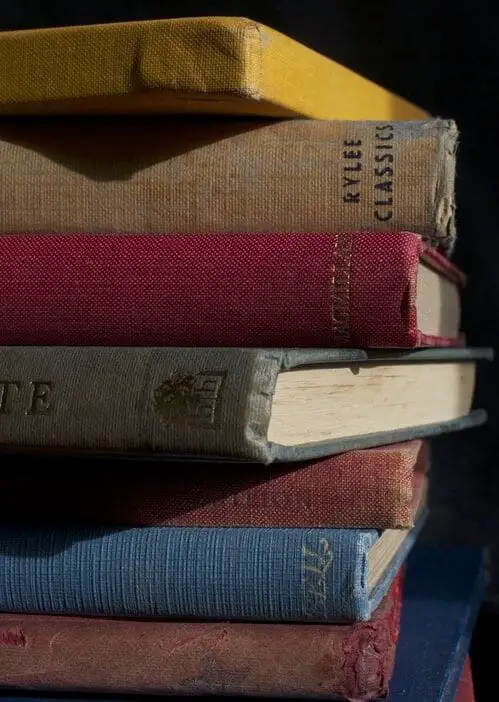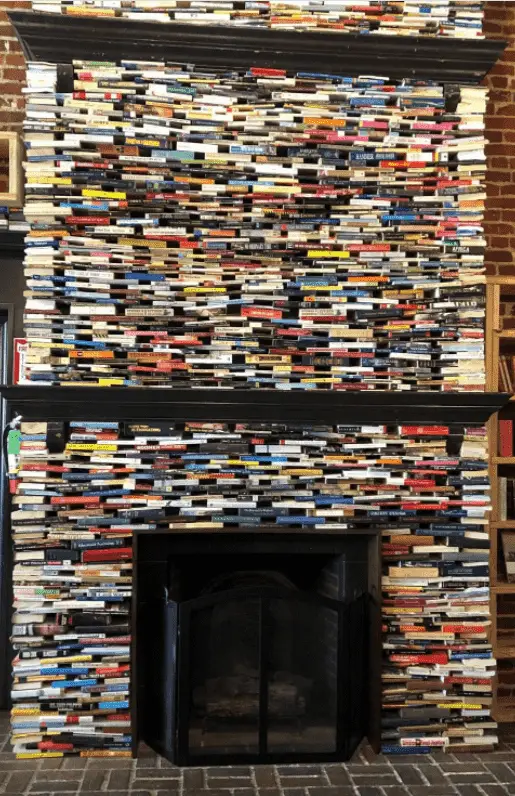Old vintage hardcover books come in many different styles and I’ve always been fascinated by everything about them. The materials used for covers, the cloth, the copyright pages, that distinctive old book smell – these have always spoke to me even as a kid so it should be no surprise that I would end up becoming a book hound. Add in a love of history and vintage book collecting is obviously something that is right up my alley!
Living in the Midwest, there were plenty of old books around. Not just from auctions or estate sales, but even garage sales would sometimes pull out books from the 1930s and 1940s…or sometimes even before. So riches abound, right?

Well…only sometimes.
As we discussed in another article, not all antique books are valuable. There are many old books that are well over a century old, but not worth anything to collectors. Some have their own cool little quirks that some of us find really cool, others just are a relic of an old past.
While my main focus as an amateur book hound was looking for books to re-sell or making sure Mom and Dad didn’t have an antique book listed at a pittance because they didn’t know what they had, but there we many old books I kept for myself even when they had no sale value.
To me, ones that clearly indicated a different time, a change, or something that clearly was from a different age just had a living history to it that I loved.
Book titles with words like:
- Moving Pictures (instead of movies)
- Aeroplanes
- Horseless Motor Car
Just fascinate me. It was a peek into a time many decades before I, or even my father and sometimes grandfather, was born, and yet gave a peek into how the world was changing then.
These were books I tended to keep even if there was no monetary value and the stories themselves were…very basic by all modern standards. In other words, of no major contributor to literary history, either.
But there’s just something about books where the very words used in a title puts it in a very specific world, a specific point in history, a specific point of Americana. It’s just so interesting to me as a book nerd, a history nerd, and someone who just finds these glimpses in time so incredibly fascinating.
So if you find yourself with many old or vintage books that aren’t valuable, what can you do with them?

What to Do with Non-Valuable Old Books
There are plenty of options when it comes to what you can do with non-valuable old books. One of the first things is to make sure a book might not qualify as collectible. Hardcover “elementary math” books and 1920’s medical books have been sold to niche collectors for a tidy little profit.
If it’s about trains or a very local area from a small press, these are books you may want to shop around to see if you can find a collector who might have a particular interest.
Assuming you’ve done the proper homework to make sure you have no hidden gems in the remainder books, what are your viable options? What can you do with books that have no historic, monetary, or collectible value?
Here are several ideas to answer that question.
Keep Based on Personal Interests
This is something I’ve already touched on a bit earlier. While not everyone is going to enjoy seeing Old Tyme words and spelling in the books the way that I do, for others there might be something else that is fascinating. I bought my brother a copy of Washington Irving’s biography of George Washington, which is usually valuable but these books had clear water and mold damage.
In addition to being made completely monetarily worthless from the clear mold and water damage (which generally automatically zeroes out a collectible book’s monetary value), they were fairly worn.
However, all the books were in one piece and it took a small amount of repair work to make the bindings solid once again. While the damage is done, the books are appropriately dried that there was no fear of mold spreading. While the books were worthless from a monetary standpoint for collectors because of the damage, for any history buff or early American literature fan, having an actual Washington Irving published book from the 1800s was just great.
Not every book will fit into a personal interest, but there’s no reason to feel guilty about having your own little collection because you simply like something about the books.
Gift to Young Readers
Many of the non-valuable old hardcovers I’ve found are fairly simply written, and are good learning books. These could be decent donations to school libraries, or to little family members who are taking to reading and would appreciate an old book with some history behind it.
This is, of course, assuming the books are focused on topics or stories appropriate for younger children, but many of the old vintage books I find at auctions are the types of books a grandparent or great grandparent might have read when they were but a child.
This can make them good gifts to kids in the family who will appreciate them, and keep some use and value out of those books for a few more years, especially the ones that were written for children or younger readers.
Collect or Catalogue Illustrations
More than once I found an old book too damaged to be considered valuable, but with wood engravings in the book that were beautiful on pages that were undamaged. While the far majority of the time I don’t condone cutting pages out of old books, if a book has severe mold and water damage, torn cover, but some interior pages seem untouched – save those pages!
The illustrations, the art, and some of the other unique work that can appear from older works are worth preserving are better removed and protected with plastic shielding in that case rather than let them rot with the rest of the damaged book.
In those very specific cases, it’s worth saving the undamaged pages worth saving (and cataloguing them for future collecting, sale, or use).
Recycle Useless Vintage Books
While I’m not happy about this option because my instincts tell me that it’s not how old vintage books should be treated, that there’s always a place or use for them, that’s just simply not true.
Not every book was a masterpiece, and while a book in and of itself was something of value at one point in time, the same mass production that allowed the wonderful gift of widespread reading and widespread literacy also lead to widespread publication of books that came and went without notice.
Recycling is better than throwing them away, and it’s even worth noting that recycling doesn’t have to be the traditional method of recycling. Imagine art, sculptures, or other creative uses for old books that no one wants to read but brings new life to them.
One example (noting this was done with a variety of new books, but the concept is solid) would be the amazing book sculpture of a giant fireplace at Ryan Holiday’s bookstore in Texas, pictured below. While this specific thing works best with the newer books, the colorful book covers, the point is the ideas of doing something creative can apply to older books no one wants.
There are options.

In Conclusion
Not every old vintage book is going to be a winner when it comes to pure value or worth. However, if you love certain types of books, know others who do, there are plenty of options. Not everything is a winner, but going to a recycling center isn’t the only fate. You can pull illustrations, use good bindings for other projects, or find dozens of other personal projects where the chaff of the purchases can still find use or even new life.
Each person is going to have their own thoughts, and while some would be upset at the prospects of removing illustrations, or making historic decorations, the sheer number of old books that otherwise or just being passed around and falling into disrepair, I’d rather see them take on new life than end up in a box in a barn where the elements leak through or any other place where they will rot away.
There are many potential ways to help old books that aren’t collectible find new life, and I’m all about doing so.
Other Articles You May Enjoy
